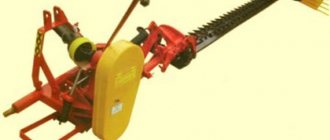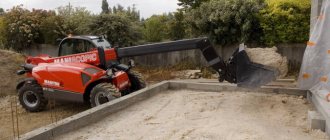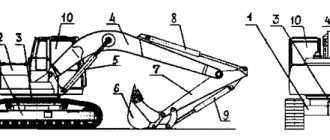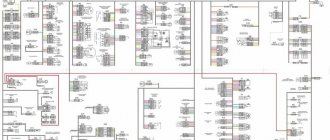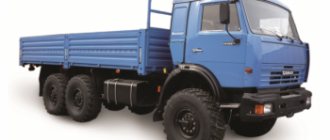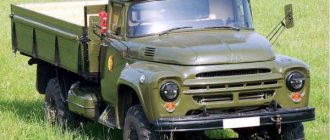Author: zaMKADpride
18 September 2022 08:32
Tags: KrAZ USSR cars all-terrain vehicles trucks laptezhnik equipment tractors
44204
7
The KrAZ-255B was nicknamed “Laptezhnik” for the wide-profile VI-3 tires of variable pressure installed on it. The car turned out to be a long-liver - it lasted on the assembly line for 26 years. During this time, 160,372 trucks were produced in various modifications and purposes.
0
Source:
See all photos in the gallery
In July 1967, the KrAZ-255B entered the assembly line of the Kremenchug Automobile Plant, where it remained until 1993. During this time, 160,732 vehicles of the KrAZ-255B/B1 family were produced, of which only in the export-tropical version the company sold more than 30 abroad 000 copies And how many chassis were exported as part of various special products is known only to the archives of the VO “Autoexport” and the secret departments of the State Committee for Electric Power Engineering of the USSR. The largest production of cars in this series occurred in 1978–1987, when 7,500–8,000 units rolled off the assembly line annually. The new product that appeared then differed little in appearance from its predecessor, the KrAZ-214B. The only thing that caught your eye was the wide tires installed on it, like bast shoes. This is where the nickname “laptezhnik” came from.
History of the model range
The KrAZ 255 could well have become a reflection of the Soviet Union. As big, powerful, and durable as a tank, for which there are no barriers. First of all, production was focused on the use of equipment in the event of hostilities.
In addition, in those days the country was actively developing the lands of the Far North. The state needed equipment that would allow, in completely off-road conditions, to transport large loads from quarrying to receiving stations - quickly, accurately and reliably. That is why the Kremenchug Automobile Plant received the task from the party council to develop transport that would meet the needs of the industry of the North.
So the engineers began their work, and in the late 70s (1967) the KrAZ-255 saw the light of day, which, after a series of tests, was recognized as an ideal vehicle for transporting goods in the North.
For their contribution to the development of the country, the design center of the plant of the former Ukrainian SSR received high state awards.
Then changes were made to optimize fuel consumption, power and other technical indicators. Until the KrAZ-255 was taken out of production in the early 90s of the last century, due to the separation of the Ukrainian SSR from Russia. It was replaced by other models. And now the KrAZ-255 can only be bought second-hand from those who still use this equipment.
Purpose
KRAZ 255 is a classic all-terrain vehicle for the most difficult road conditions. The vehicle has a variety of both civilian and military specialties. In the national economy, the car was used in logging, in the geological exploration industry, in production and various types of construction, in agriculture and aviation support.
In the military field, a truck is used to transport people with equipment, transport various weapons, and engineering equipment and military systems for various purposes are installed on the chassis (from anti-aircraft guns to electronic warfare systems). Over a long period of time, the car was purchased by Latin American countries, China, Pakistan, India and almost the entire “socialist camp,” which speaks volumes about its high performance in almost any weather and climatic conditions.
Specifications
Without thinking twice, Kremenchug designers equipped the then-new KrAZ with a 14.9-liter V8 diesel engine. Traction gain reached 883 N.M., and power - 240 horsepower. With such equipment, the flint-auto could easily reach a speed of 71 km/h. The cooling system held more than 50 liters of liquid, while 32 liters of oil were required.
Perhaps this figure will scare even Dodge Nitro owners. Of course, the advantages of this tractor did not lie in the comfortable interior. The 6x6 formula means that KrAZ had three drive axles. Consequently, any, absolutely any route did not seem to be anything serious for the Kremenchug all-terrain vehicle. In addition to its own weight, this brutal truck tractor could easily carry 10 tons of cargo with it, practically without losing its performance characteristics.
Motor
Power units with good displacements under the name YaMZ-238 were used as internal combustion engines in the car. Development began in 1950. The most standard diesel fuel was used as fuel. It is interesting that its quality did not play a special role - after all, in the combustion chamber, EKTO class fuel and dilapidated USSR diesel fuel burned equally well.
YaMZ-238 has the following distinctive elements of the device:
- The modern modification has received turbocharging equipment (previously it was not installed);
- The engine can come with six or eight cylinders;
- Number of working cycles – 4;
- The power supply system is controlled by a high-pressure fuel pump (HPF) with a mechanical drive;
- The cylinder block is made of cast iron;
- Coolant is responsible for cooling a functioning engine;
- The cylinders were positioned at 90 degrees to each other (V-shaped);
- The lower mechanism division is OHV, where the valves are located at the top;
- The distance from BDC to TDC is 140 mm.
Based on the fact that a simple mechanical high-pressure fuel pump is responsible for the engine power supply system, each cylinder has its own personal pumping station. And they already provide direct fuel injection (diesel). Thanks to this, such a huge torque (1765 N/m) was achieved. The volume is 15 liters. Intake lines found their place in the very collapse of the cylinder block. The OHV fit alongside the crankshaft. It is driven by a pair of gears, which are attached to the front of the motor housing. The number of valves for each piston was set - 2 valves.
Engine characteristics
| Modification | engine's type | Engine capacity | Power | Transmission | Acceleration up to 100 km/h, sec. | Maximum speed km/h |
| KrAZ 255 14.9 MT | Diesel | 14860cm³ | 240 hp | Mechanical 5st. | — | 71 |
Fuel consumption
For 100 km of travel, the tractor requires about 40 liters of fuel. Thanks to two large tanks (165 liters each), the vehicle's power reserve is 750 km.
Transmission
If we talk about the clutch, then the Kremenchug truck used a YaMZ-238, which had two discs. In addition, there were peripheral springs and a mechanical shutdown drive. The YaMZ-236N model transmission had five speeds, with synchronizers at the second, third, fourth, and fifth speeds. The transfer case of the KrAZ 255 had 2 stages, and was also supplied with a center locking differential of the rear and middle axle. The transfer case was controlled using three levers. The cardan transmission consisted of five shafts: gearbox - transfer case, transfer case - front axle, transfer case - middle axle, transfer case - rear axle (a pair of shafts with an intermediate support). The main transmission of the drive axles was double, the arsenal of which included bevel spiral and cylindrical spur gears.
Transmission devices
- Clutch friction unit;
- Has two disks;
- The device contains coil springs;
- The discs operate without lubrication or oil bath.
Due to the fact that the Kremenchug Automobile Plant developed the KrAZ-255 truck quite a long time ago, it does not provide for the possibility of installing an automatic transmission. Based on this, the machine works in tandem only with mechanics, which have the following structural features:
- Fixed shaft axes are used;
- There are gears that are in constant mesh (removing the 1st and reverse gears);
- Gearbox – three-way;
- Availability of five speeds;
- There are synchronizers that compensate for the lack of a divider (which is used in KamAZ) and operate in 2-3 and 4-5 gears.
The transfer case itself has the following features and technical characteristics:
- Division – mechanical;
- Has a power take-off shaft (applied to the winch);
- It has a pair of stages and a center differential.
The cardan transmission has several main parts:
- Open shafts;
- Intermediate supports;
- Cardan shafts.
The KrAZ's equipment includes three drive axles, with which it is known throughout the world as a very passable truck. The front axle has some peculiarity - there are CV joints. They transmit torque to the front wheels when turning. The KrAZ-255 truck suspensions have the following characteristics:
- Installed in front - rests on two semi-elliptical springs, which are equipped with two hydraulic shock absorbers operating in both directions;
- Placed at the rear - it rests on a pair of longitudinal semi-elliptical springs, which are equipped with three pairs of reaction rods.
Brakes
They operate with a drum device, where the release is carried out using a cam and brake cylinders. A double-circuit pneumatic drive is used, where the 1st goes to the front and middle axles, and the 2nd to the rear. The parking brake is a transmission, drum-type, mechanically driven one. It is installed on the output shaft of the transfer case and transmitted to the rear axle. There is also a spare brake system - one of the circuits of the functioning brake.
Auxiliary - a retarder installed in an engine that has a pneumatic drive. The trailer brake is a combination. Moreover, there is a moisture separator, which has a thermodynamic cleaning of compressed air from moisture, as well as a fuse against freezing of condensate on alcohol.
The brake system is of a standard type and differs only in its considerable weight. It includes:
- Brake pads;
- Brake drums;
- Availability of pneumatic drive and vacuum booster;
- Auxiliary brake motor (produces deceleration).
The braking distance of a truck at a speed of 40 km/h is 17 meters, and at the same speed, but with a trailer, it is 18.5 meters.
Auxiliary equipment
The KrAZ-255 is equipped with not only military equipment, but also civilian equipment. The machine has:
- Device for pre-start heating of the engine;
- Function for adjusting air pressure in wheels (on modifications 255B and 255B);
- Winch design (on machines 255B and 255L);
- Special equipment for moving timber;
- Coupling device.
In 1979, an improved modification of the KrAZ-255 B1 was put into production, which was not very different in technical features from the standard version - this modification had a separate brake drive. Starting in the 1970s, the car underwent changes that affected the appearance of the car - now the headlights and direction indicators began to be placed in rectangular metal boxes. Before restyling, they were located separately.
The Kremenchug truck was equipped with a pair of fuel tanks, each of which held 165 liters of diesel fuel. With such a tank volume, the power reserve was enough for 750 kilometers. Fuel consumption was 30-40 liters per 100 kilometers. To turn around, Kraz needs 14.5 meters of road surface. For special needs, the vehicle is able to overcome a small ford, the depth of which is no more than one meter.
Based on the fact that the car is quite large, the volume of consumables is quite large. KrAZ has the following list of consumables:
- The cooling system requires 51 liters of antifreeze or antifreeze;
- For good lubrication of the engine during its operation, 32 liters of engine oil are required;
- The hydraulic booster requires 3.9 liters;
- To lubricate the transfer case, 16 liters of oil are required;
- The steering housing requires 1.25 liters of oil;
- All 3 axles must be filled with 12 liters of specialized gear oil;
- For adequate operation, each shock absorber requires 0.75 liters of oil.
Regardless of the year of production of the truck and the use of obsolete systems in the device, it continues to be found on the roads to this day. This happens for various reasons:
- It has reliable qualities and characteristics;
- Good maintainability;
- All required parts can be purchased without much difficulty;
- Low pricing policy, especially taking into account opponents.
Engineering technology. Chassis with piling equipment for organizing crossings
0
Source:
It’s worth dwelling on the latter in a little more detail. It was with the advent of the KrAZ-255B that it became much more compact and mobile. The PMP included 32 river units, four coastal units, four lining units and 16 towing boats. All this was placed on 54 single vehicles, instead of 98 Zils with trailers. For example, one KrAZ-255B transported one link, consisting of two middle and two outer pontoons, connected by hinge joints. In the transport position, the link was folded. The assembly of the floating bridge took place along the river. The KrAZ vehicles, lined up in a row, were reversing into the water. On command, each driver released the stopper securing the link to the car, and it slid down the rollers into the water. Then the link automatically unfolded within a minute. The further operation was to join each link into the bridge strip with the help of tugs. The time it took to erect a 60-ton bridge during the day was 30 minutes.
Device
Externally, the KrAZ-255 looks rather unpretentious. The wooden cabin, which seats three, is lined with steel and is located behind the engine. The instrument panel is simplified as much as possible and has a small number of primitive indicators and mechanisms. In 1969, the appearance of the truck changed somewhat. The front part received a new lighting system mounted in a single rectangular body. Also in the cabin were windshield washers, an updated seat with a spring suspension, a set of additional settings and a hydraulic shock absorber, a panoramic glass heater, a removable sleeping bed and a heating system. The driver's seat became sprung and was adjusted for height and weight.
The body of the KrAZ-255 is made in the form of a metal cargo platform with a lattice side that opens at the rear, arches, side folding seats and an awning.
Appearance
You definitely shouldn’t expect aesthetic innovations from the KrAZ-255. The wooden cabin was upholstered with steel sheathing and placed behind the engine. Beginning in 1969, designers slightly changed the lighting system by installing lights and turn signals in a steel body. Before this, the truck tractor was equipped with a separate box with lights.
The turn signals, which originally had a teardrop shape, were also changed. The body of the KrAZ-255 was a cargo platform, in the rear part of which a lattice side opened. On the sides there were folding seats, arches and an awning. Thanks to the wide-profile tires, in the USSR this car was called “Laptezhnik” - a nickname that has stuck with the tractor to this day. The curb weight of the tractor is 11.55 tons.
Dimensions
The maximum possible elevation angle will be 58. The Kremenchug truck weighs about 12 tons. The speed limit is 70 km/h. The significant dimensions (8.64 m long and 2.16 m wide) could not but affect the turning circle, which exceeds 14 meters.
Cabin
But the designers paid special attention to ease of use. Their efforts were crowned with success. The pneumatic power steering was subsequently replaced by hydraulic power steering. Convenience of control is added by the levers of the gearbox, brake (also manual), axle differential, transfer gear and front axle installed in the cabin. There was also a winch mechanism lever. They decided to make the driver's seat sprung, there was a sleeping bed and two additional seats for passengers. The instrument panel has been simplified to the maximum.
Dimensional parameters of KrAZ-255
The overall dimensions of the KrAZ vehicle are quite large, but are quite justified by its purpose:
- width including awning or side platform – 2,750 mm;
- length from the front bumper to the towbar (if provided for by the design) – 8,645 mm;
- height from the rubber tread to the highest point of the awning – 3,175 mm;
- weight excluding transported cargo and refueling liquids – 11,950 kg.
The truck cabin is equipped with three seats: two for passengers and one for the driver. The passenger seats are paired, the driver's seat is located separately. If necessary, you can easily change its height - literally with one movement of your hand.
The cabin frame is made of wood and covered with sheet steel. The thermal insulation inside is not very good, but this is more than compensated for by the powerful stove.
Modifications
There were several modifications of the KrAZ-255 truck:
- The KrAZ-255B became the base vehicle with a chassis or a platform that did not receive a chassis. Production of the truck started in 1967. It was intended for towing and transporting trailers and cargo over various terrain. The KrAZ-255B chassis was actively used for the installation of drilling rigs, pile driving machines, excavators, cementing units and other types of equipment;
- KrAZ-255B1 – version with separate brake drive. Its production began in 1979;
- KrAZ-255V is a truck tractor used for towing semi-trailers weighing 26 tons on paved roads and 18 tons on any roads;
- KrAZ-255D – modification with an active semi-trailer MMZ-881;
- KrAZ-255L is a timber carrier equipped with a TMZ-803K trailer.
Load standards for KrAZ-255
The car in question is very durable. It copes perfectly with all permissible loads for which it is designed:
- front axle load is 4,920 kg (fully loaded);
- on the rear two axles (second and third axles) – 6,250 kg;
- total weight of the vehicle and cargo – 19,450 kg;
- permissible weight of an additional trailer is 10,000 kg when driving on public roads;
- permissible weight when driving on roads with particularly hard surfaces is 30,000 kg.
Price in Russia
Since the car model was discontinued more than twenty years ago, unfortunately, it is impossible to purchase a new KrAZ-255. But at the same time, thanks to high demand in the USSR, many trucks have been preserved in good condition today. If you wish, you can always choose a high-quality all-terrain vehicle in good condition for about 600-700 thousand.
So, concluding the article, it is worth emphasizing once again that even such “oldies” as the KrAZ-255, which has long been out of production, can be useful in your daily work and perform tasks of any complexity. Of course, if you compare the parameters of the truck with other modern brands, it will seem very outdated, but at the same time, the price of a Soviet car is much more attractive than the cost of its Western counterparts.
If you find an error, please highlight a piece of text and press Ctrl Enter.
Since the MAZ 255 car is no longer produced, you can only purchase a used car. The price for 15-20 year old cars starts from 300 thousand rubles. There are copies removed from storage. The price of such machines after re-opening can reach up to 2 million 500 thousand rubles.
At the combat post
Despite the fact that Laptezhnik has become widely used in various sectors of the national economy, it is no secret that it was created, first of all, for the needs of the country's armed forces.
It is noteworthy that combat complexes and weapons systems were not installed on the KrAZ chassis, however, it became the base vehicle for army engineering services. Each of the modifications of special engineering vehicles built on the basis of the KrAZ-255B is unique and deserves a detailed description. Most of them are successfully used today.
Kraz-255 PMP at work
The Soviet-made pontoon crossing system was in service not only with the Warsaw Pact member countries, but also with some capitalist countries. For example, the PMP on the KrAZ chassis is still in service with the Finnish army.
The heavy mechanized bridge TMM and the combined arms mobile excavator EOV-4421, which is operated not only by engineering units of the armies of the CIS countries, but also by the UN peacekeeping contingent, turned out to be technically perfect.
A lot of special equipment based on the KrAZ-255 has been created for airfield support units. These are various modifications of fuel tankers, unique airfield installations for monitoring the hydraulic systems of heavy transport aircraft, fire hydrants, and towing vehicles.
The air defense forces are well known for the radar rangefinders installed on the Laptezhnik chassis; KrAZ trucks were also used as transport-loading vehicles for missile systems. In the Strategic Missile Forces, KrAZ-225V truck tractors were used to tow semi-trailers with missile systems.
In the armed forces of the allied states of the USSR, combat complexes were created on the basis of the 255th. Thus, in Angola, surrogate armored personnel carriers were built on the KrAZ-225B chassis; in Cuba, the truck was adapted for a self-propelled artillery mount with an armored cab. In the North Korean armed forces, after lengthening the truck frame, the S-125 Pechora air defense system launch complex was installed on its chassis.
Laptezhnik in deserts and tropics
The foreign career of our “Laptezhnik” deserves a separate discussion. It was thanks to the interest shown in the truck by foreign customers that the Laptezhnik, unlike most Soviet trucks of that time, received a fairly wide range of colors.
At first, all serial Kremenchug trucks were painted in a protective color. However, after the All-Union Association “Avtoexport” managed to promote the new product of the Soviet automobile industry to the markets of Africa and Asia, the “Laptezhnik” in export version, at the request of customers, began to be painted in sand color.
Over the years of production, KrAZ trucks were exported to 50 countries around the world. They appeared on the roads of all continents, excluding Australia and Antarctica. Among other advantages, the truck stands out for its durability. Even after many years after the cessation of production, they can today be found not only in our country, but also where they were exported many years ago.
In Europe, most of them are in Poland and Germany. After the transition to NATO standards, the armed forces of the former socialist countries began to decommission Soviet equipment. Most of the cars ended up in the hands of private operators. In Poland, on the basis of former military KrAZ vehicles, tow trucks for vehicles were built, and in Germany, many fan trucks appeared that transport tourists in mountainous areas, participate in various auto shows, and some examples even become flagship cars in wedding processions.
A worthy heir to traditions
The need to modernize the KrAZ-214B model, which was quite successful for its time, but outdated in a number of technical parameters, arose in the mid-60s, and by 1967 Kremenchug automakers mastered the serial production of a new model of an all-wheel drive three-axle heavy truck. At the same time, the design of the truck has undergone significant changes.
KrAZ-214B from the plant museum
Externally, the new KrAZ was not much different from its predecessor. Perhaps only the new wide-profile tires indicated that the truck belonged to a new modification. It was thanks to the tires that the truck received its nickname “laptezhnik”, which took root among all those who operated this vehicle.
But the design of the truck itself has undergone major changes. And, first of all, this is a replacement of the power unit. The six-cylinder two-stroke diesel engine was replaced by a more powerful and economical V-shaped four-stroke eight-cylinder power unit YaMZ-238.
YaMZ-238
Let's compare some technical characteristics of the old and new modifications. The maximum speed increased from 55 km/h to 70 km/h, while fuel consumption decreased from 120 to 70 liters per 100 kilometers. Half a ton more than the previous model, with approximately the same curb weight.
However, VI-3 tires differed not only in their tread pattern and width. For the first time in the history of KrAZ trucks, the vehicle was equipped with a centralized tire pressure regulation system, which was controlled from the driver’s workplace. For example, when driving in deep snow or quicksand, the driver could reduce the tire pressure in just a few minutes from 3.8 to 1.0 atmospheres.
At the same time, the tire pressure on the supporting surface increased by 70%. As a result, the pressure of the wheels on the ground decreased, helping to increase the truck's maneuverability. This is the principle of operation of the centralized tire pressure control system. In 1979, the twelfth year of serial production, a more efficient dual-circuit braking system began to be installed on the 255th.
Engine
Most of the 255 KRAZ vehicles produced are equipped with a YaMZ-238M2 engine.
- Type – four-stroke, compression ignition;
- Number and arrangement of cylinders – 8, V-shaped;
- Working volume – 14.86 l;
- Power at a crankshaft speed of 2100 rpm – 240 hp. (176kW);
- Maximum torque at a crankshaft speed of 1250-1450 rpm – 883 Nm (90 kgf.m);
- The minimum specific fuel consumption is 214 g/kW.
The engine is equipped with a PZD-44MBU pre-heater.

